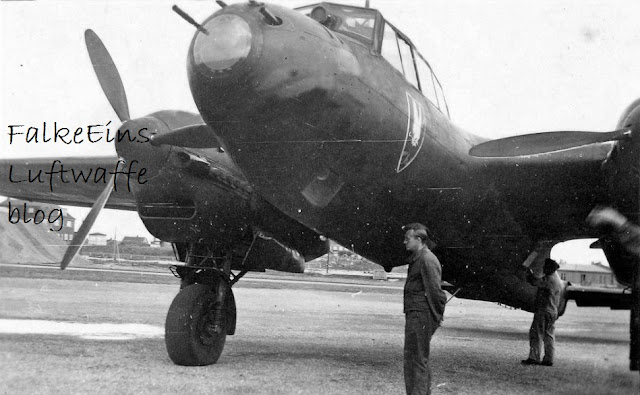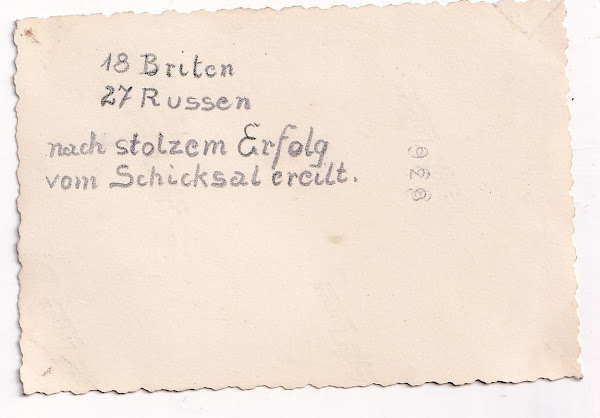Following on from their recent 'Luftwaffe in Tunisia' (Jean-Louis Roba) and 'Last victory in the Mediterranean' ( Jean-Louis Roba with Chris Shores) Lela Presse have just published their latest 'BATAILLES AÉRIENNES' monograph, 'The Luftwaffe in Italy 1943-45' by Jean-Louis Roba. Coverage of bomber, fighter, transport and recce units is based on archival documents including POW interrogation reports and features plenty of first-person accounts. French text. Still well worth acquiring at only 13 euros - 96 pages, 150+ photos, profile artworks - but easy enough to read with, for example, the google translate app on your smartphone..
IV- Transport units
In the course of the resupply operations flown into the Tunisian pocket, the German Transportgeschwader (the designation TG had replaced the former KGzbV in April) had suffered terribly. Above all else, there was a shortage of escorts for the Ju 52 and Me 323 transports. On April 22, the ‘infamous’ disaster at Cap Bon took place - fourteen TG 5 Me 323 six-engine behemoths were shot down with their passengers and cargoes.
- TG 5 continued to be based on its aerodrome at Pomigliano to supply the islands. One Me 323 pilot, Oblt. Ernst Peter*, recalled:
"..After the operations in Tunisia, our unit flew almost daily from Naples-Pomigliano to Sardinia, with the handful of aircraft that remained and those that could be brought to us from Leipheim. For a while we were able to enjoy life. From time to time we would see, far above us, the condensation trails of an enemy reconnaissance plane that had come to watch the area or, sometimes, tight formations of heavily laden bombers arriving from Africa to sow death near the Alps. We could continue on our way because these formations were not at the same altitude as we were and any potential fighter escorts they might have did not care about the transport planes flying at much lower altitudes. It was a nice feeling to be able to fly alone, not having to rely on a fighter escort and only having to rely on yourself. We did not have to endure the attacks on our runways like Cagliari/Elmas, Alghero, Venfiorita/Olbia, Decimomannu, Villacidro or Milis, so it was a good time and, after the costly and hard operations in Africa, almost a relief even though we often had to fly for three hours over a sea stretching as far as the eye could see. We mainly refuelled the 90. (leichte) Division with fuel, Flak equipment, vehicles, ammunition, etc..."
* "..schleppte und flog Giganten"
The strains within the German command
The Bf 109s of the 'Pik As', based in Sicily, were to bear the brunt of the powerful air attacks on the island. On 18 May, suitably escorted four-engine bombers dropped their ordnance on Pantelleria and Trapani. Eight P-38s were claimed but no bombers - a testament to the quality of the escort. On the 19th, the USAAF targeted Trapani and, although six Lightnings and two Curtiss were claimed, again no bombers fell victim to the 'Pik As'. That day, 7./JG 53 lost two of its pilots. On the 20th, Spitbombers from Malta bombed Comiso. And so on... These almost daily attacks gradually wore down the Sicilian defence units.
JG 77's first major combat since the evacuation from Africa, however, did not take place until June 18, in the Sardinian sector of Olbia. In support of local Italian units, III./JG 77 faced a large formation of B-25s escorted by P-38s of the 27th, 96th and 318th FS. Two P-38s, three B-25s and a Boston were claimed by the three Staffeln, who seem to have lost no aircraft.
The Allies had barely paused after the capture of Tunisia. On the night of 10/11 June, they began their invasion of Europe by landing at Pantelleria. On 12 June, after the small Italian island of Pantelleria, the island of Lampedusa surrendered almost without a fight.
Confronted with these rapid Allied actions it was decided to completely overhaul the German command in the Mediterranean;
-all Wehrmacht units in the south came under the control of Marshal Albert Kesselring hastily appointed OBS Süd (Oberbefehlshaber Süd);
-Luftflotte 2 was taken over by the energetic Field Marshal Wolfram von Richthofen, cousin of the famous Great War pilot;
-the bomber units dependent on II. Fliegerkorps were regrouped under the Fernkampfführer Mittelmeer, Oberst Dietrich Peltz. Peltz (who in 1941 had led the dive-bombing school at Foggia) was to attempt to instil the new tactics that had been honed in the West against the UK and to develop various measures such as attacks at low altitude or the movement of units to more distant airfields, in order to reduce the risk of destruction by Allied bombers.
However, given the large number of units assembled in a restricted space that had now become a front line, the Germans faced serious logistical problems, as Karl Gundelach pointed out;
"…In Sicily, it was necessary to find new airfields for the fighter and the Schlacht units. This was difficult because very often all that was available was just farmland. Göring received many complaints from his Kommandeure about the slowness of the Italians to find solutions (...) It was also necessary to reinforce the Flak arm; especially the batteries defending the vital Straits of Messina. (...) It was planned to establish barrage balloon booms here, but the Italians preferred to keep them for their own ports. (…).Aerodromes in Sardinia had to established and air transport to the island stepped up. The Allied air forces then sent their long-range aircraft to disrupt this air traffic, which led to losses. (...) The greatest difficulties were in Calabria, where there was a lack of aerodromes for fighters. The best equipped were in Apulia but they were too far away for the Tagjäger. (...) Following the heavy losses of the Flak in Tunisia and the equipment which had been abandoned there, there was a lack of batteries. Most of them were to be assigned to Sicily but Sardinia needed 15% of the manpower that had been gathered. It was therefore necessary to bring in anti-aircraft units from northern Italy at the risk of undermining the protection of the industrial towns working for the Axis war effort… "
These problems undermined local command in the face of a numerically superior enemy. Added to this was Göring's mistrust of the Jafü Sizilien, General Theo Osterkamp, who had been installed in this position by OBS Kesselring. Osterkamp had already been removed from the command of a Geschwader by Göring as early as 1940, the Reichsmarshal considering him too old to exercise such responsibilities.
On June 25, a large formation of B-17s passed north of Sicily to raid Naples. II. and III./JG 53 as well as elements of JG 77 were guided towards the bombers from the ground. II./JG 53 missed its interception while JG 77 could only put up a very brief fight due to lack of fuel. Two B-17s were claimed by two aces of III./JG 53 ( 55th victory for Oblt. Schiess and the 68th for Oblt. Roehrig) but Uffz. Alfred Kowaleswki (9./JG 53) was shot down over the Straits. Two other Fortresses were also downed. Enraged by this 'incompetence', Göring demanded that Inspector of Fighters Galland ensure that one pilot from each Gruppe be brought before a court martial and tried for 'cowardice before the enemy' (Feigheit vor dem Feind)....
Web site of publisher Lela Presse is
here












.jpg)








.jpg)
.jpg)











